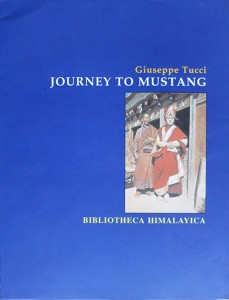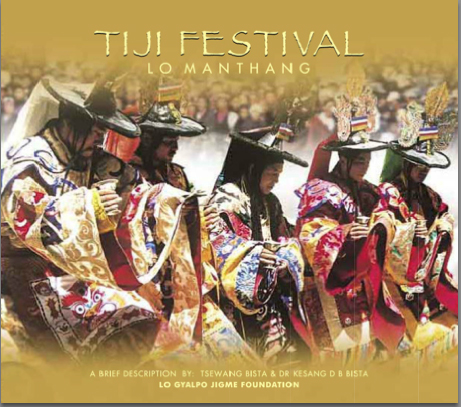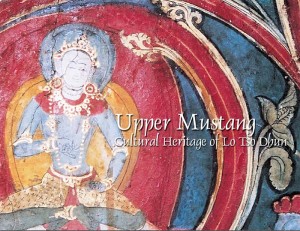Founded in the early 1400’s, it’s the capital of the ancient Lo empire and controlled the overland trade between Tibet and Nepal for hundreds of years.
The place is very isolated and most people still walk there from Jomson.
Giuseppe Tucci traveled there in 1952.
Soon after his trip, China invaded Tibet and the Dalai Lama fled to India.
The area was closed to visitors because a gorilla army operated out of there to fight against the Chinese in Tibet.
Tucci paints a picture of a very hard and isolated country. He encountered crippling poverty, endemic diseases and the deaths of three of their porters.
He was also very pessimistic about the fate of the ancient buildings and the religious art of the area.
Many were in a crumbling state even back then.
Jump forward to 1992 and Peter Matthiessen and Thomas Laird plus minders, officials, porters and horses travel overland from Jomsom to Lo Monthang.
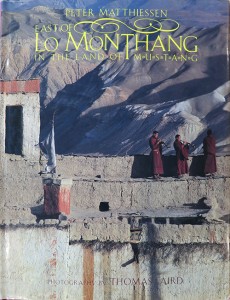
East of Lo Monthang, In the Land of Mustang, Peter Matthiessen, Photography Thomas Laird, Shambhala, Boston, 1995
Matthiessen makes no mention of leprosy, sees no starving beggars and loses no porters to disease.
However, it is clear that much of the art has been looted, either by gorilla armies looking to fund their campaigns or art thieves.
Some of the crumbling ruins have vanished but many sound as if they are in a better state of repair than in 1952.
The book has some stunning images but even though it’s May, he describes cold winds, freezing streams and occasional snow. (I HATE the cold – so am stocking up on thermals etc – even have a couple of emergency heat packs!)
For the next book, we jump back to 1964 when a mad Frenchman, Michel Peissel, who has dreamed of Tibet from a youngster, after badgering authorities in Kathmandu, is given a pass to all of Mustang and is the first European to go there since the invasion of Tibet by China.
This is a very tense time, with a Khampa gorilla army camped all over the region to carry on the war against the Chinese. if that’s not bad enough, his closest traveling companion is wanted by the Khampas and would possibly be shot if his identity were to be discovered!
With his companions, they walked more than 400 miles through very rough terrain, more than a few times facing life threatening circumstances.
His book gives some great insights into the life of the Lobas (citizens of Lo). From sex and marriage to succession and old age to burial and rebirth. Since he spoke Tibetan, he was able to converse with kings and commoners alike and even made close friends.
It’s a fascinating insight into the people, politics, religion, history and daily life across the whole of the Kingdom of Lo.
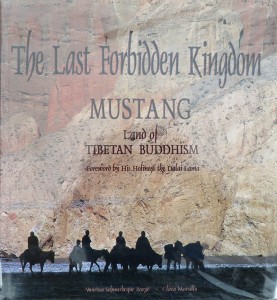
The Last Forbidden Kingdom, Mustang, Land of Tibetan Buddhism, Vanessa Schuubeque Boeye, Clara Marullo, Thames & Hudson, 1995
This book was written in the early 1990’s. It has some great pictures in it and while really a picture book, it does provide some interesting facts about history and the temples (or gompas) in Tsarang, Gilling and Lo Manthang.
It’s unique pitch is about the then state of tourism in Lo. Apparently this was entirely controlled from Jomsom. Locals were not even allowed to sell common things to tourists or provide them with accommodation or services. THe picture it paints at the end of the future for the Kingdom of Lo is not rosy. Let’s hope their predictions did not come true.
I was able to download this pamphlet from the UNESCO website (unesco.org).
While short on detailed explanations, its give a historical context to the festival and also gives a blow by blow description of the three days of the festival.
Here is another publication from UNESCO. This one is a bit more challenging as it was an internal publication related to the UNESCO long term plans for the whole region of the Lo Tsu Dhun.
But, it does have some really good information on the culture, history, economy, religion and cultural heritage.
